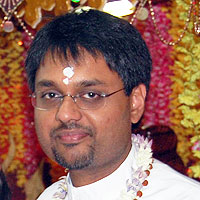From a satsang with Pt. Dr. Umesh Persad, Spiritual Leader, SWAHA Gyaan Deepak Kirtan Mandali
In Hinduism, each form of God is not just an external divinity, but also a reflection of a quality or universal principle within oneself. Furthermore, the names and forms of the Divine is an idea of the higher self, of who we truly are.
Shree Hanuman is undoubtedly one of the most versatile characters of the great Shree Raamcharitramaanas epic and a perfect servant of God and humanity. The meaning of his relationship to his parents is also instructive. Vayu, the wind God, is Hanuman’s father. Vayu means ‘the blower’ and comes from vaata meanng ‘movement by the wind’. Hanuman is considered the mind principle and his father is the breath or life force in the body. In yoga practices, the breath is used to steady and quieten the restless monkey mind.
In terms of Shree Hanuman’s name, firstly, Hanu means ‘wisdom’ and man means ‘thought’ or ‘mind’. Hanuman, therefore, means ‘one having wisdom, knowledge and right thinking’. In Sanaatan Dharma, wisdom is attained from the Guru and the religious scriptures that allows us to develop right thinking.
Hanu also means ‘to destroy’ and man means ‘pride’. Hanuman is the destroyer of pride. He is representative of humility. Humility, it is said, is not thinking less of yourself; it is thinking of yourself less. It is a state that must emerge from the ultimate knowledge of who we are in reality. It arises from the realisation that we are not different entities but, instead, that we are all one.
Ha also means ‘to destroy’ and anuman means ‘inference’. There comes a point when analysis and thinking cannot take you any further along the spiritual path. It says in the Shree Raamcharitramanas, that the mind itself is delusion. In order to experience the Supreme Being, we must transcend the mind. Ha also means Shiva, of whom Shree Hanuman is considered a manifestation; anu means ‘beyond’ and man means ‘thought or mind’. The scriptures say that the Self can be found in that space between thoughts. When we stop thinking, all that remains is Shiva, the Self. This may be better understood by the analogy of the clouds and sky: the clouds are like the temporary thoughts that drift across the mind; the sky, however, is always present. The goal is to realise that we are the sky and not the clouds.
In the mythology, child Hanuman flew up to the sky and tried to eat the sun which he thought was a juicy, ripe fruit. This can be interpreted to mean that in this world, we are always looking for ripe fruits everywhere that we can enjoy. We try to find fulfillment in his world but, like Hanumanji, we are struck back down to earth by Indra’s lightning bolt. Indradev, representative of our senses and mind fight against us in our worldly pursuits.
As Hanuman fell from the sky, he hit his jaw; similarly, we lose faith in the world. In the mythology, Hanuman’s father, Vayu, the wind, stopped blowing. This stillness of mind is a technique that we must use to advance spiritually. The Yoga Sutras say that yoga is stillness of mind. In becoming mentally still, we achieve spiritual powers and realise the Self in all. We understand who we truly are and then nothing in this world can shake us.



